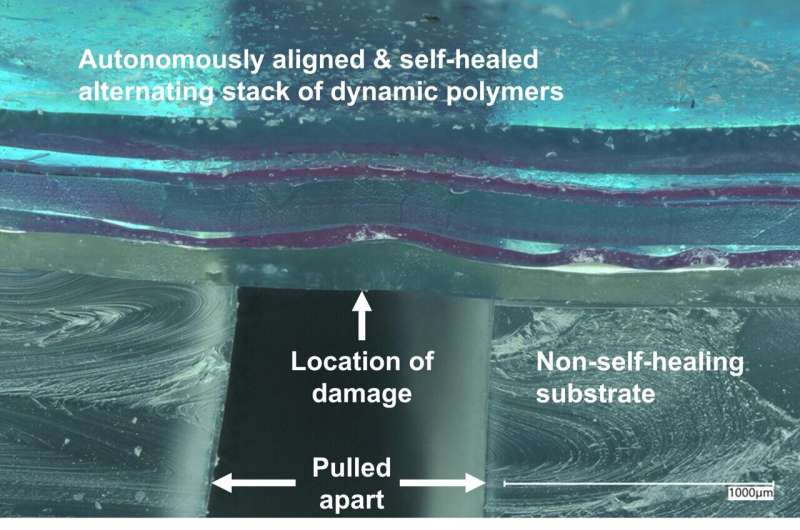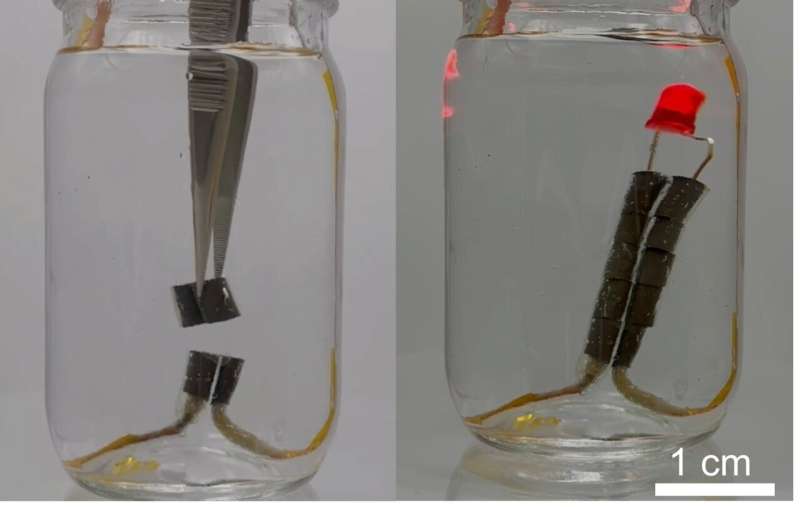Layers of self-healing electronic skin realign autonomously when cut

Human skin is amazing. It senses temperature, pressure, and texture. It’s able to stretch and spring back, time and again. And it provides a barrier between the body and external threats—bacteria, viruses, toxins, ultraviolet radiation and more. Engineers are, accordingly, keen to create synthetic skin. They imagine robots and prosthetic limbs that have skin-like qualities—not the least of which is skin’s remarkable ability to heal.
“We’ve achieved what we believe to be the first demonstration of a multi-layer, thin film sensor that automatically realigns during healing. This is a critical step toward mimicking human skin, which has multiple layers that all re-assemble correctly during the healing process,” said Chris Cooper, a Ph.D. candidate at Stanford University who, along with postdoctoral researcher Sam Root, is co-author of a new study published in Science.
Layering is critical to mimicking skin’s many qualities. “It is soft and stretchable. But if you puncture it, slice it, or cut it—each layer will selectively heal with itself to restore the overall function,” Root says. “Just like real skin.”
Skin, too, is formed of layers. It has just evolved immune mechanisms that rebuild the tissue with the original layered structure through a complex process involving molecular recognition and signaling.
“With true ‘skin’ the layers should realign naturally and autonomously,” Cooper says.
Root says the team, led by Professor Zhenan Bao at Stanford University, might be able to create multi-tiered synthetic skin with individually functional layers as thin as a micron each, perhaps less. Thin enough that a stack of 10 or more layers would be no thicker than a sheet of paper. “One layer might sense pressure, another temperature, and yet another tension,” says Root. The material of different layers can be engineered to sense thermal, mechanical, or electrical changes.
A novel approach
“We reported the first multi-layer self-healing synthetic electronic skin in 2012 in Nature Nanotechnology,” says Bao. “There has been a lot of interest around the world in pursuing multi-layer synthetic skin since then.” What sets their current work apart is that the layers self-recognize and align with like layers during the healing process, restoring functionality layer by layer as they heal. Existing self-healing synthetic skins must be realigned manually—by humans. Even a slight misalignment in layers might compromise functional recovery.
The secret is in the materials. The backbone of each layer is formed of long molecular chains connected periodically by dynamic hydrogen bonds, similar to those holding the double-helix of DNA strands together, that allow the material to stretch repeatedly without tearing. Rubber and latex are two well-known natural polymers, but there are countless synthetic polymers, too. The key is to design polymer molecular structures and choose the right combination for each layer—first layer of one polymer, the second of another and so forth.
The researchers used PPG (polypropylene glycol) and PDMS (polydimethylsiloxane, better known as silicone). Both have rubber-like electrical and mechanical properties and biocompatibility and can be mixed with nano- or microparticles to enable electric conductivity. Critically, the chosen polymers and their respective composites are immiscible—they do not mix with one another yet, due to the hydrogen bonding, they adhere to one another well to create a durable, multilayer material.
Both polymers have the advantage that when warmed they soften and flow, but solidify as they cool. Thus, by warming the synthetic skin, the researchers were able to speed the healing process. At room temperature, healing can take as long as a week, but when heated to just 70°C (158°F), the self-alignment and healing happen in about 24 hours. The two materials were carefully designed to have similar viscous and elastic responses to external stress over an appropriate temperature range.
“Skin is slow to heal, too. I cut my finger the other day and it was still healing four or five days later,” Cooper says. “For us, the most important part is that it heals to recover functions without our input or effort.”

A step further
With a successful prototype, the researchers then took things a step further, working with Professor Renee Zhao at Stanford University, adding magnetic materials to their polymer layers, allowing the synthetic skin to not only heal but also to self-assemble from separate pieces. “Combining with magnetic field-guided navigation and induction heating,” says Zhao, “we may be able to build reconfigurable soft robots that can change shape and sense their deformation on demand.”
“Our long-term vision is to create devices that can recover from extreme damage. For example, imagine a device that when torn into pieces and ripped apart, could reconstruct itself autonomously,” Cooper says, showing a short video of several pieces of stratified synthetic skin immersed in water. Drawn together magnetically, the pieces inch toward one another, eventually reassembling. As they heal, their electrical conductivity returns, and an LED attached atop the material glows to prove it.
Among their next steps, the researchers will work to make the layers as thin as possible and toward creating layers of varying function. The current prototype was engineered to sense pressure, and additional layers engineered to sense changes in temperature or strain could be included.
In terms of future vision, the team imagines, potentially, robots that could be swallowed in pieces and then self-assemble inside the body to perform non-invasive medical treatments. Other applications include multi-sensory, self-healing electronic skins that form-fit to robots and provide them with a sense of touch.
More information:
Christopher B. Cooper et al, Autonomous alignment and healing in multilayer soft electronics using immiscible dynamic polymers, Science (2023). DOI: 10.1126/science.adh0619. www.science.org/doi/10.1126/science.adh0619
Citation:
Layers of self-healing electronic skin realign autonomously when cut (2023, June 1)
retrieved 1 June 2023
from https://techxplore.com/news/2023-06-layers-self-healing-electronic-skin-autonomously.html
This document is subject to copyright. Apart from any fair dealing for the purpose of private study or research, no
part may be reproduced without the written permission. The content is provided for information purposes only.
For all the latest Technology News Click Here
For the latest news and updates, follow us on Google News.

